Our several day storm blew off to points east this morning but low clouds hung over the summit of the mountain until late in the afternoon. At times like these I was grateful for the tram cam that let me see whether or not the mountain was covered in fog or the sunshine I was waiting for.
After it was readily apparent that the clouds would lift or burn off, I headed out for the tram, wishing that I could have had an earlier start. I wasn’t sure what to expect, although I was suspicious that the snow pack would probably be wet, or close to it. All the snow that had fallen over the previous two days was gone from my back yard, and even more telling, my pond was not frozen over.
I knew that there would be opportunities to capture the white against the blue, especially the deep blue of the high altitude sky. I had no idea that I would have a photographic opportunity that I just probably won’t ever have again.
I went for the snow, the sun and the contrast that actually makes some of the images quite difficult to shoot since the camera cannot record nearly as well as the eye.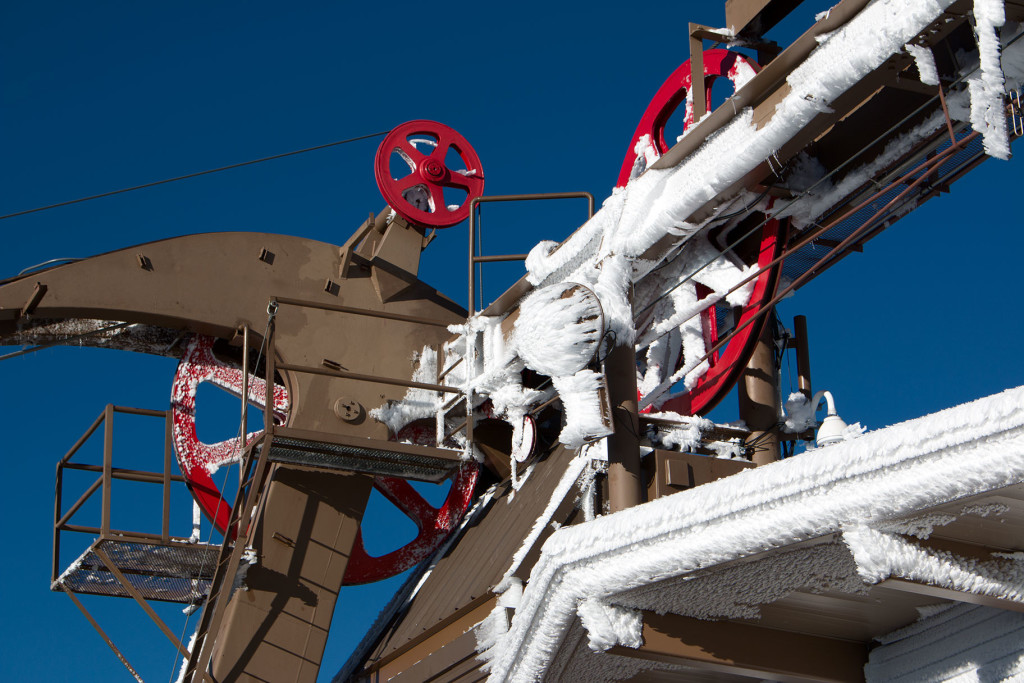
Besides the view and the raw beauty of the mountain, I think that one of the things I enjoy most about my winter excursions is the extreme nature of it all. Fresh snow on a 45 degree slope with drop offs just one step away makes for a deliberate approach to the day. The high alpine environment with its howling winds and bone chilling winds makes a good deal of this mountain off-limits, especially in the winter.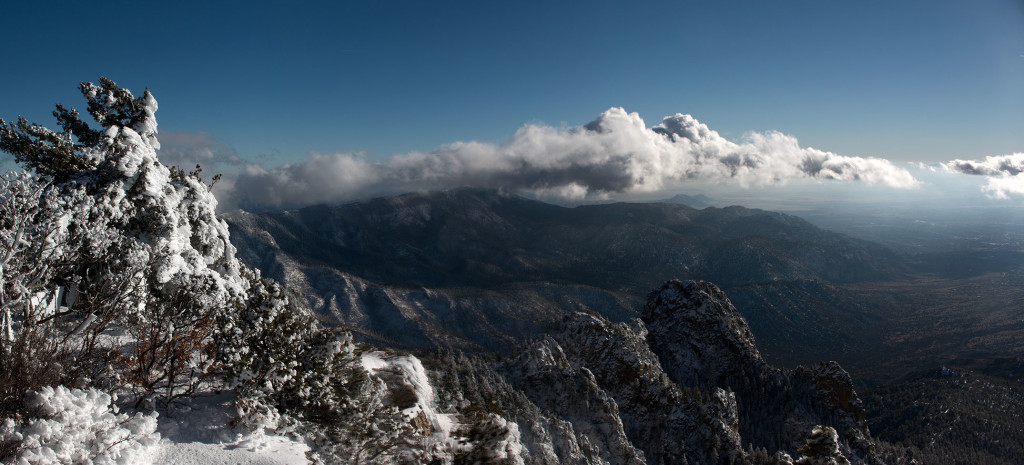 Today I was not to be the first, for there were two sets of footprints on the trail. I couldn’t tell if they were coming and going or if two people came across the trail from the north.
Today I was not to be the first, for there were two sets of footprints on the trail. I couldn’t tell if they were coming and going or if two people came across the trail from the north.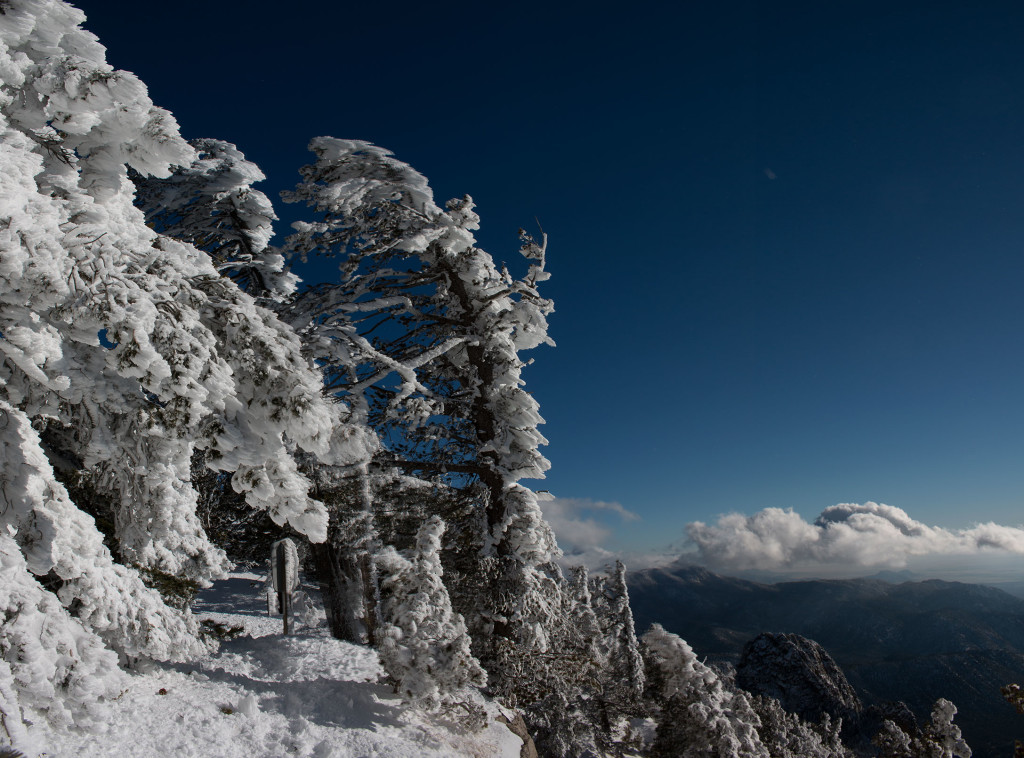 The trees bend to the east, but since the majority of the snow blew in from the east, it’s the west side of everything that is coated in a layer of packed snow. (The image above is a panorama made from three vertical shots. It’s a bit blurred in one spot but it’s the best I could do under the circumstances.)
The trees bend to the east, but since the majority of the snow blew in from the east, it’s the west side of everything that is coated in a layer of packed snow. (The image above is a panorama made from three vertical shots. It’s a bit blurred in one spot but it’s the best I could do under the circumstances.)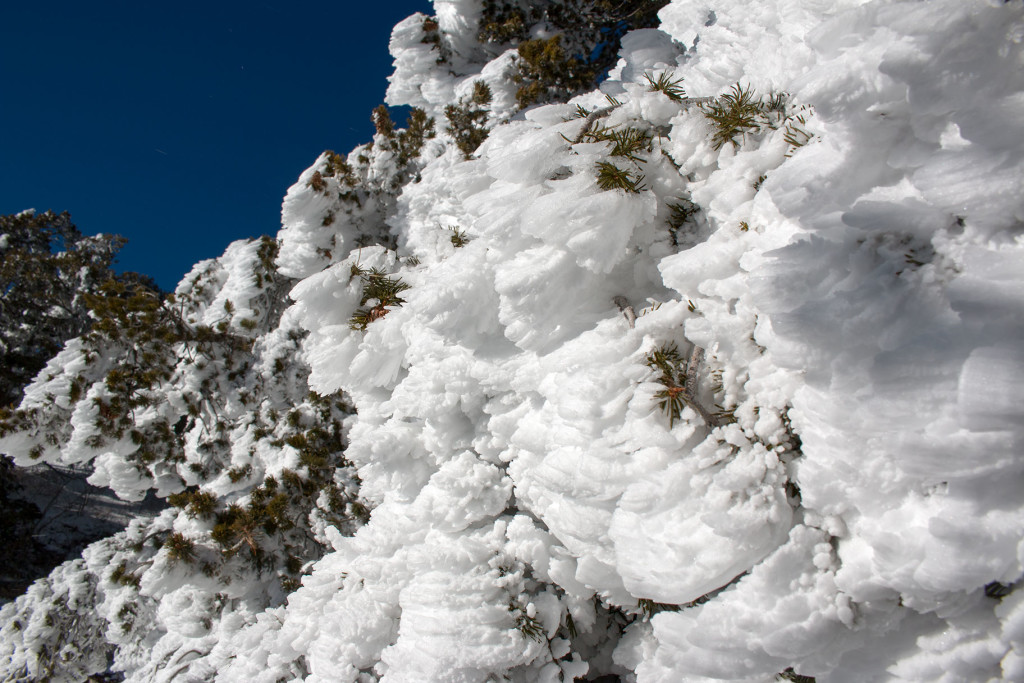 The snow underfoot did turn out to be both wet and crusty. True to form, the exposed slopes were the first to melt and in some places the trail was covered in just an inch or two of slush. For the first several hundred yards I walked only in my boots and switched to snowshoes only after I got tired of crunching through other footsteps. Also, the snow that was falling off of the trees had filled in many of the foot prints on the worst slopes. I decided it would be safer and easier to return on a packed path and took the time to strap everything on.
The snow underfoot did turn out to be both wet and crusty. True to form, the exposed slopes were the first to melt and in some places the trail was covered in just an inch or two of slush. For the first several hundred yards I walked only in my boots and switched to snowshoes only after I got tired of crunching through other footsteps. Also, the snow that was falling off of the trees had filled in many of the foot prints on the worst slopes. I decided it would be safer and easier to return on a packed path and took the time to strap everything on.
True to form, the trail was deserted. This was my fifth trip to the top of the mountain this year and third time that I was completely alone.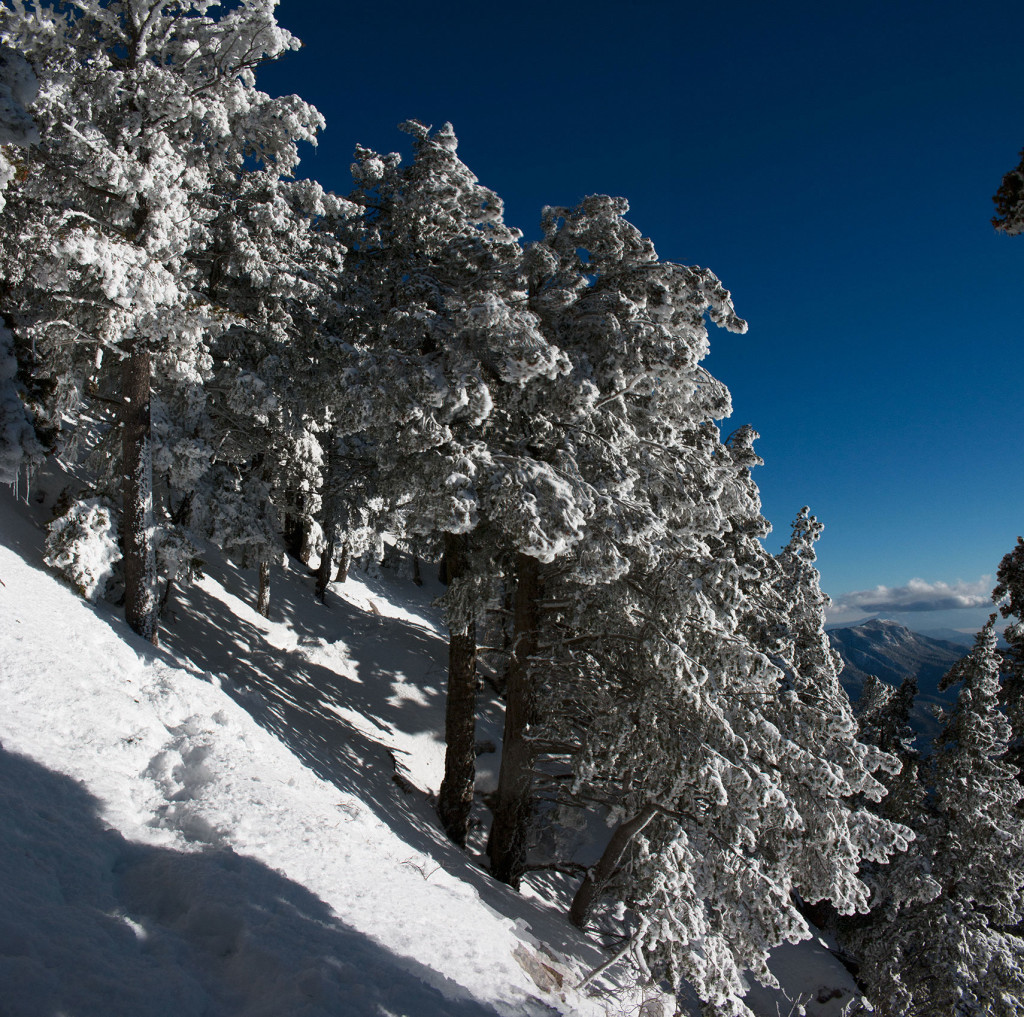 Another composition of three vertical images. The south peak is in the background on the far right. On a big screen the enlarged image gives you a great perspective of the slope on this side of the mountain.
Another composition of three vertical images. The south peak is in the background on the far right. On a big screen the enlarged image gives you a great perspective of the slope on this side of the mountain.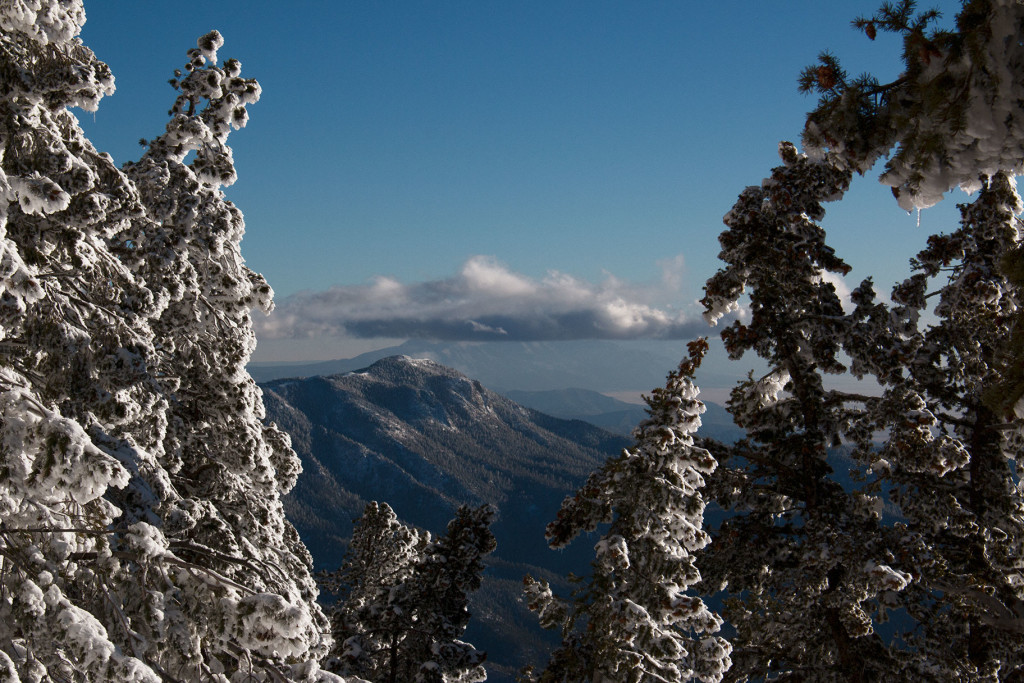 Fortunately the last of the clouds had moved off to the south and soon evaporated in the late afternoon sun.
Fortunately the last of the clouds had moved off to the south and soon evaporated in the late afternoon sun.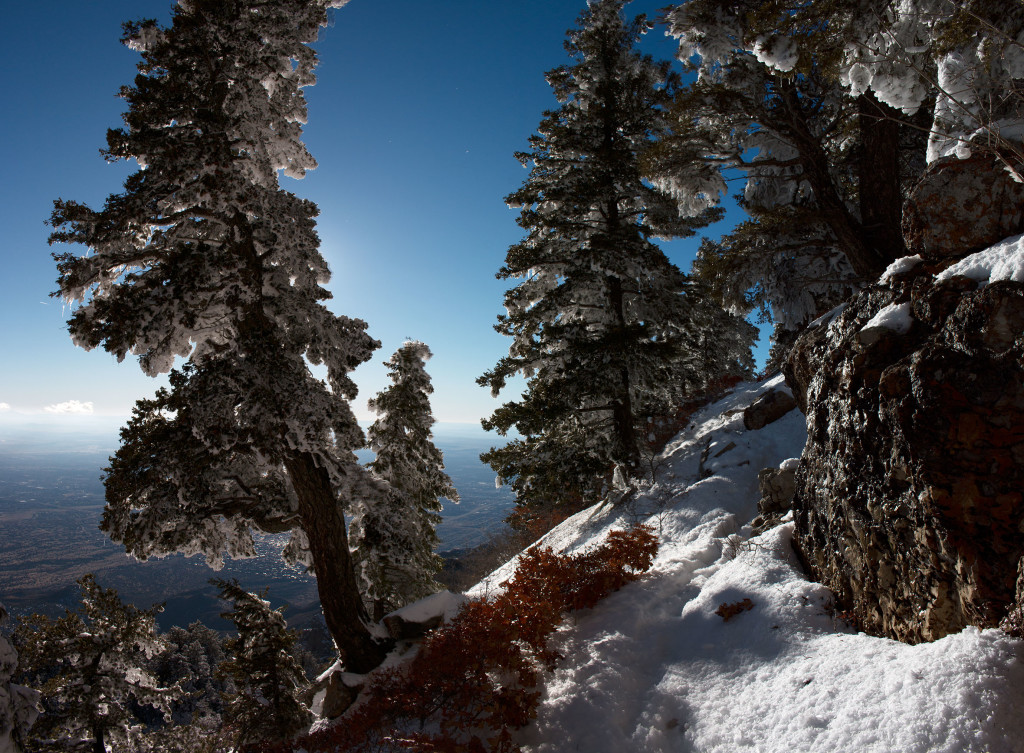 Although the ambient temperature was only 27 degrees, the focus of the sun at high altitude quickly was melting the covering of snow. You can see the water on the rock on the right. Just a couple of hours prior one of my friends told me that great sheets of ice were falling off of the rocks just a bit lower down on the mountain. I suspect that may be my next effort, trying to catch the experience of cascading ice.
Although the ambient temperature was only 27 degrees, the focus of the sun at high altitude quickly was melting the covering of snow. You can see the water on the rock on the right. Just a couple of hours prior one of my friends told me that great sheets of ice were falling off of the rocks just a bit lower down on the mountain. I suspect that may be my next effort, trying to catch the experience of cascading ice.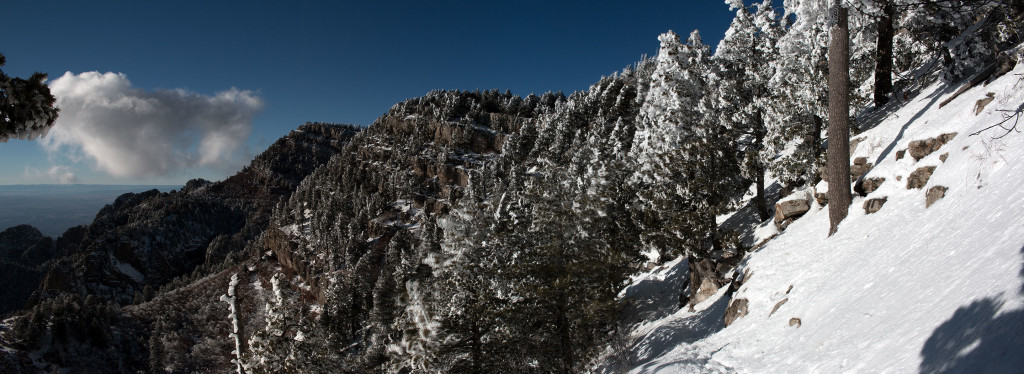 My primary objective this trip was to get out to an overlook that you can spot just beneath the cloud on the far left of the image. There is a bright patch of snow that can barely be seen on this image, but on the full-sized photo you can see it clearly. From this point I suspect that it is about a half-mile away.
My primary objective this trip was to get out to an overlook that you can spot just beneath the cloud on the far left of the image. There is a bright patch of snow that can barely be seen on this image, but on the full-sized photo you can see it clearly. From this point I suspect that it is about a half-mile away.
That overlook has a great view of all of Albuquerque and points west, but it also has a great view of a significant part of the southern range of the summit. My thought was to shoot a panorama of the southern range in the bright light, then hopefully get one in the golden light, and then finally another when it turned pink for just a few moments as the last light of the sunset spreads over the mountain. My first panorama is a group of 14 vertical images that reaches deep into the Manzano mountain range. This is what I was planning to capture when the sun began to set. I had planned to sit out on my perch over the city and just wait for the light to change. Because it was so far from the tram however, I wasn’t really happy with the idea of hoofing it back in almost darkness. I don’t mind a twilight crossing of the snow, but I was concerned about ending up in the dark. There was a head lamp in my backpack as an emergency backup.
My first panorama is a group of 14 vertical images that reaches deep into the Manzano mountain range. This is what I was planning to capture when the sun began to set. I had planned to sit out on my perch over the city and just wait for the light to change. Because it was so far from the tram however, I wasn’t really happy with the idea of hoofing it back in almost darkness. I don’t mind a twilight crossing of the snow, but I was concerned about ending up in the dark. There was a head lamp in my backpack as an emergency backup.
I moved around for a second set of images that focused on the unbroken snow in the foreground. Although I was happy with the unbroken snow and I thought it would reflect the light well, the primary snow-covered face of the range was not visible from this vantage point. I decided to break the snow and circle around to where I could the face of the mountain clearly.
Although I was happy with the unbroken snow and I thought it would reflect the light well, the primary snow-covered face of the range was not visible from this vantage point. I decided to break the snow and circle around to where I could the face of the mountain clearly.
That’s when I saw it.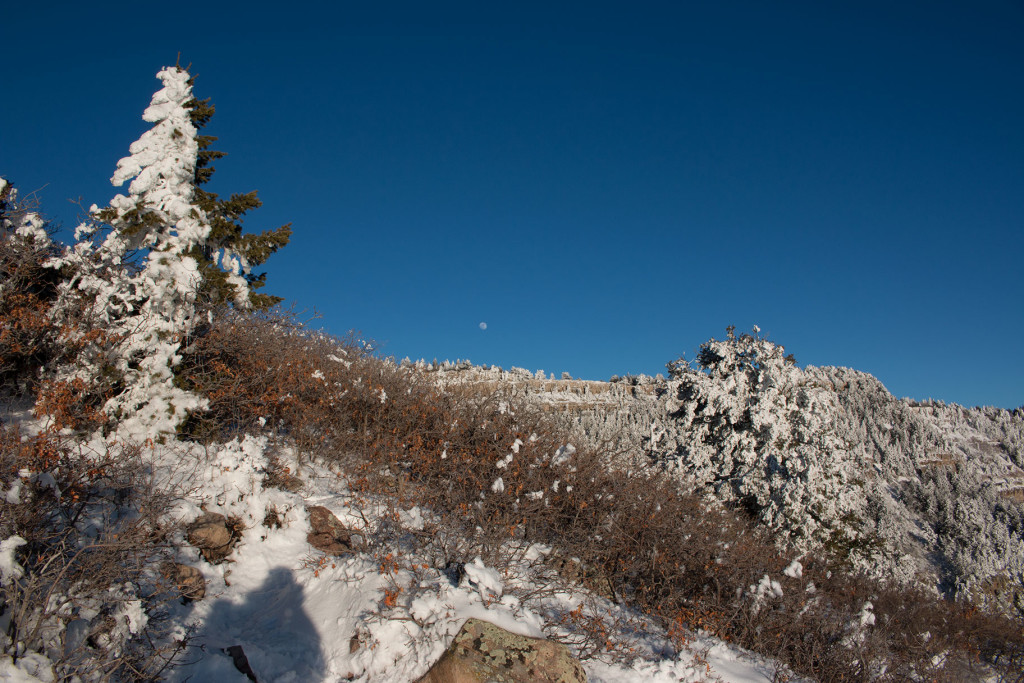 From here, and with the normal lens I was using, it didn’t look like much and I shot a few test images with the lens I had, but it still had not clicked that this was a unique situation.
From here, and with the normal lens I was using, it didn’t look like much and I shot a few test images with the lens I had, but it still had not clicked that this was a unique situation.
Here’s what was so unique. If I hustled up closer to the ridge, the moon would disappear as I got closer. Then every time it got a bit higher in the sky than I wanted, I could just walk closer to the mountain and set up for it to rise again.
But this would only work on Sunday. Monday’s moon rise would take place about 50 minutes later and the sun would be set before it rose above the ridge. So here are the variables, fresh snow and the moon rise in the clear after the snow, crossing the ridge a little after 5pm.
How many days a year does that happen? Remember, the snow melts of the trees generally in one or two days max. Oh, yeah, you gotta be there with the camera and the big lens as well.
I was excited as I changed lenses and headed off toward the ridge. A bonus was that I would be closer to the tram on my walk back. Next, a panorama in the golden light.
Next, a panorama in the golden light.
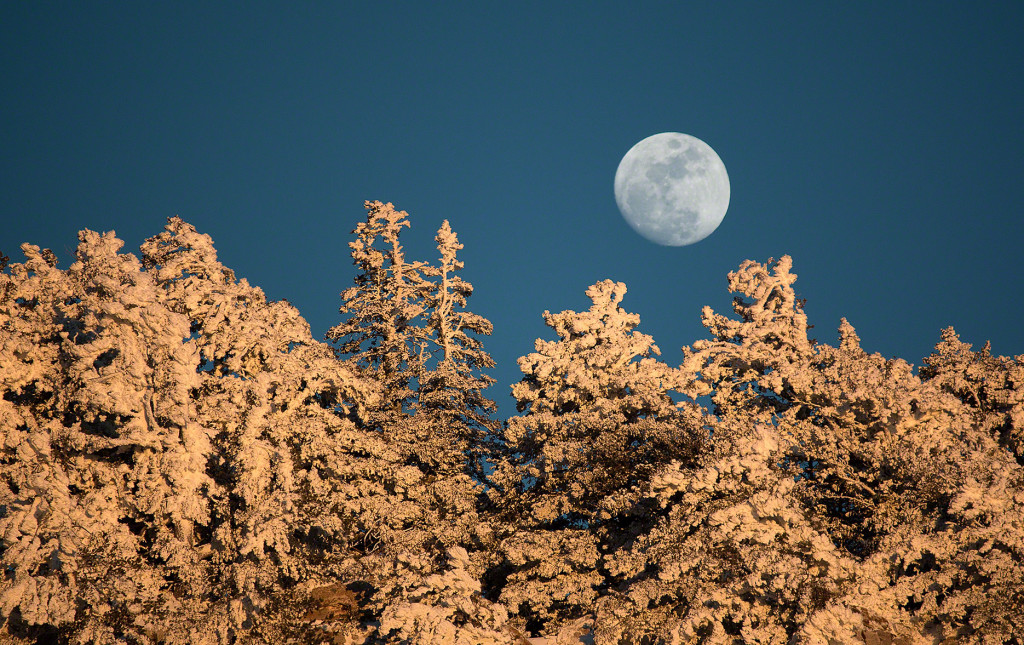 Finally, the moon in the Sandia.
Finally, the moon in the Sandia.
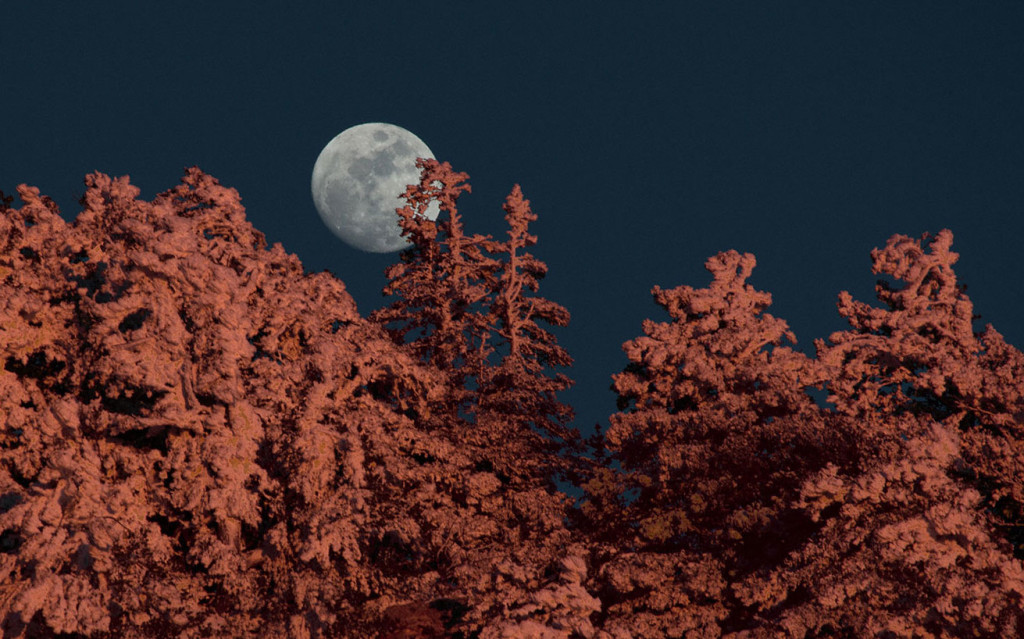 All in all it took just over 2 hours to get all of these. I got back just as it turned dark but didn’t need my headlamp. After my last set of moon shots my fingers were so cold that I had to stop and put them under my jacket to warm them up enough. As soon as I could I put on two pair of gloves for the trek back. All in all it was worth the effort.
All in all it took just over 2 hours to get all of these. I got back just as it turned dark but didn’t need my headlamp. After my last set of moon shots my fingers were so cold that I had to stop and put them under my jacket to warm them up enough. As soon as I could I put on two pair of gloves for the trek back. All in all it was worth the effort.

Pingback: Photos of the Day, February 1, 2015 » Wanderings